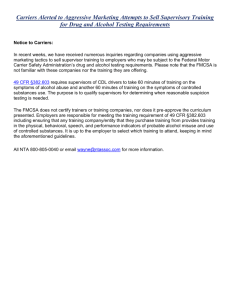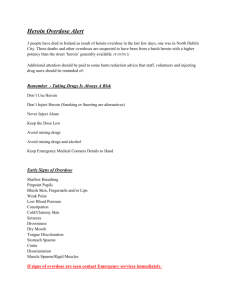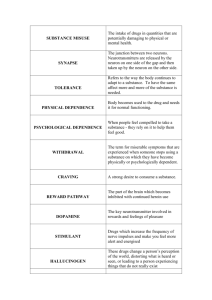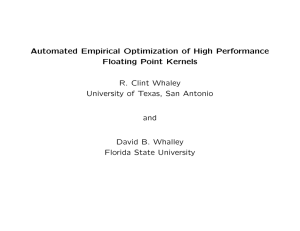From Methadone and the National Treatment Agency to Alcohol
advertisement
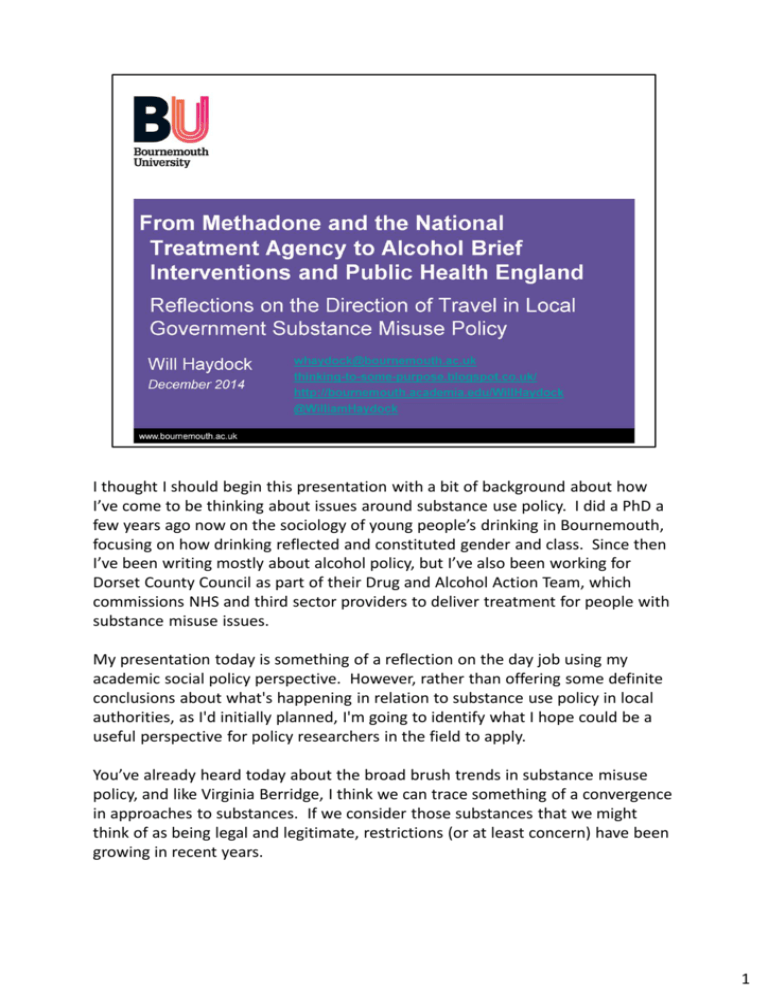
I thought I should begin this presentation with a bit of background about how I’ve come to be thinking about issues around substance use policy. I did a PhD a few years ago now on the sociology of young people’s drinking in Bournemouth, focusing on how drinking reflected and constituted gender and class. Since then I’ve been writing mostly about alcohol policy, but I’ve also been working for Dorset County Council as part of their Drug and Alcohol Action Team, which commissions NHS and third sector providers to deliver treatment for people with substance misuse issues. My presentation today is something of a reflection on the day job using my academic social policy perspective. However, rather than offering some definite conclusions about what's happening in relation to substance use policy in local authorities, as I'd initially planned, I'm going to identify what I hope could be a useful perspective for policy researchers in the field to apply. You’ve already heard today about the broad brush trends in substance misuse policy, and like Virginia Berridge, I think we can trace something of a convergence in approaches to substances. If we consider those substances that we might think of as being legal and legitimate, restrictions (or at least concern) have been growing in recent years. 1 Take alcohol. Despite the idea that licensing laws have been liberalised in the UK, there’s an underlying philosophy with considerable traction that emphasises that alcohol is harmful in itself – and population measures such as minimum unit pricing are genuinely being considered. There’s also designated public place orders and Reducing the Strength' campaigns that restrict where and when people can drink alcohol, and even what can be sold. 2 On tobacco, advertising restrictions have been imposed over the past few decades, and we’ve recently had standardised packaging introduced in Australia, and packs being kept behind closed doors in the UK. 3 Restrictions on caffeine are being debated, and I’ve heard plenty of substance misuse professionals and youth workers worrying about energy drinks. 4 At the same time, thinking about currently illegal substances, there’s a great deal of media coverage for the Global Commission on Drug Policy, which follows Transform’s ideal of heavily regulated legalised substance use. And in practice, a number of US states (and other countries) have liberalised their policies on certain previously illegal substances – notably cannabis – that mean consumption and sometimes even retail is legal. Transform’s model of legalised consumption isn’t so far away from where we currently are with tobacco in the UK: condemned and controlled, but legal. 5 Throw into this mix the ‘disruptive innovations’ we’ll be hearing about later of ecigarettes and ‘legal highs’ and there’s an interesting mix where the old lines between licit and illicit substances aren’t so clear. The planned approach of the Coalition to ‘legal highs’, where all psychoactive substances would be illegal by default except where they have already been legalised, highlights the inconsistency in allowing alcohol, tobacco and caffeine consumption, for example, and some people would hope this will open up a debate about why these differences exist. But this sort of analysis is primarily based on big, largely national policy announcements. I don’t think there’s anything wrong with this sort of approach – and it’s exactly how I approached my academic articles. But, working in a local authority over the past few years, I’ve been acutely aware of how approaches can differ from one area to another, and how the big picture might vary when considered in detail. The perspective and examples I’ll be giving today are only one element of policy – even only one element of what local areas have control over – but it should give you an idea of how there’s quite a variety of types of intervention on offer to policymakers, and these reflect different ideas of what is problematic about 6 substance use, which in turn reflect broader priorities and implications. My focus on treatment is relevant when it’s one of the few directly allocated spending budgets in relation to psychoactive substances. The starting point for this analysis is to consider the changes in funding and governance that have happened in relation to substance misuse treatment in the past few years. If you look at my main job, as a commissioner of substance misuse treatment services, for a decade or so before 2013, local areas used to be given funding for drug treatment by a specialist agency of the Department of Health: the National Treatment Agency (NTA). 6 As an aside at this point, I should note that if you're interested in the longer and broader history of drug treatment in the UK, as well as Virginia Berridge, Alex Mold has written some excellent engaging articles. 7 Now, apologies to those of you for whom this is stating the obvious, but I’ll just sketch things relatively quickly. [SLIDE] The NTA was very much a New Labour creation, and focused on a specific group of drug users, whether referred to as PDUs (problem drug users), OCUs (opiate or crack users) or more recently simply opiate users – that is, heroin. The NTA determined what funding each local authority area would receive for drug treatment, and set out prescriptive requirements for local areas in terms of how they had to plan and arrange their treatment systems. The key approach was methadone maintenance treatment, which had the logic of stopping someone injecting street heroin in favour of drinking a different, prescribed opioid. The rationale is that by reducing injecting the risk of blood-borne virus transmission is cut, and you also remove the need for that person to steal to fund their (physical) dependency because you’re giving them the methadone free. The funding for this was channelled through Drug and Alcohol Action Teams (DAATs), which were intended to be local partnerships of all interested organisations: local authorities, PCTs, Police, Probation, Prisons and so on. And crucially, in fact, much of the funding that ended up going towards drug treatment had originated from a patchwork of sources from all these organisations. 8 Regardless of the many potential justifications for funding drug treatment, the public rationale unfailingly focused on criminal justice issues. Drug treatment was a way of being ‘tough on the causes of crime’. Benefits in terms of reducing the prevalence of HIV or Hepatitis C were mentioned, but to give just one example, when the NTA released a Value for Money calculator, the detail – and the biggest ‘savings’ to the public purse – related to crimes that would be avoided if a drug user were engaged in methadone maintenance treatment. 9 Paul Hayes, the former Chief Exec of the NTA has continued to make this argument since the demise of the organisation, most recently in a Guardian article just a couple of weeks ago. This model of treatment is based on providing intensive, focused support for a relatively small group within society. The NTA provided estimates of the number of heroin and crack users in each local area, and commissioners had to show what proportion of this specific group they were engaging in treatment. Funding was to a large extent determined by how many of these people accessed drug treatment. In the new commissioning world, two things have become standard orthodoxies: First, alcohol has been the ‘poor relation’ in terms of treatment, because the NTA never explicitly granted funding for it; and Second, the old model focused on getting people into treatment rather than moving them through to ‘recovery’, however that is defined. I’ll spend more time today on the first of these claims. 10 The apparent rebalancing of treatment towards alcohol is about more than making sure that services are open to alcohol users as well as heroin users – in Dorset, for example, because of the nature of the area, we’ve already got a much higher proportion of alcohol users in our system than most other areas. The shift is emblematic of the change in governance, from the NTA to PHE (there’s always got to be an impenetrable abbreviation) – that is, Public Health England. 11 And here’s the shift, signalled in the name: ‘treatment’ to ‘public health’. The approach of public health is to think in terms of small shifts across a whole population: if we all reduce our alcohol consumption by a unit or two a week, we’d reduce the total numbers of alcohol-related deaths by a big number at an aggregate level, though the change in our individual risk would be barely noticeable. Alcohol Brief Interventions are the big tool available to local commissioners on this agenda, hence the title of my presentation. The old model of intensive treatment for heroin users doesn’t fit this new philosophy – and note that alcohol is one of PHE’s identified priorities, whereas drugs are not. People at DrugScope like Marcus Roberts and Andrew Brown have written and spoken about this point, so I don’t want to labour it here. Another crucial change in the funding approach is that money is no longer ringfenced for drug treatment (and soon won’t even be ringfenced for public health activities more broadly) – and it’s not based on performance metrics relating to heroin users. 12 Perhaps just as importantly, this is no longer (even if only in principle) a patchwork of funding tied up through partnership arrangements; it’s been wrapped up into the general local authority grant from central government (though as I say for the moment it remains ringfenced for public health). You can see how important this debate about the nature of substance use is when you look at how much of the public health budget is currently consumed by drug and alcohol treatment services. 13 How much would public health want to get their hands on that for streams of work they feel have been underfunded historically? And how much would local authorities want to siphon that off to fund the forthcoming crisis in adult social care, illustrated by Barnet’s ‘graph of doom’? 14 A recent press release from the Local Government Association actually stated this explicitly. 15 From PHE, we see the move away from that kind of exceptionalism afforded heroin (and crack) use in the past. Guidance for alcohol, illicit drugs and tobacco are now all lumped together by PHE, in another example of that convergence I was talking about earlier. 16 But the change is more than this. The changes relating to funding are part of a broader shift to local autonomy. At a UK level, lots of elements of alcohol policy at least are devolved, and you’d find a different approach to drug treatment in Scotland. This is also played out at local level – and here’s where some of my personal experience comes in. PHE guidance just doesn’t carry the same weight as NTA requirements. That’s actually the aim of the government’s localism approach, and has lots of strengths: Dorset no longer needs to produce a crack strategy when there’s hardly any crack use in the county, and it can develop a different approach to legal highs from Kent, where the supply operates much more through ‘head shops’ than in Dorset. On that issue of legal highs and local trends I can highly recommend this recent article in Mixmag by Mike Power called Small Towns, Crap Drugs. 17 But, as any political scientist worth their salt would point out, policymaking isn’t a neutral, objective process of fitting a tailored solution to a specific problem identified through detailed evidence. This autonomy means that decisions are shaped by local views, sensibilities and beliefs. It’s also important to note that, as in that Kent example, the regulation of psychoactive substances comes under the remit of Trading Standards as much as the Police, for example; there are a lot of perspectives and agencies involved with this agenda. If this presentation has any key message, it’s not really to identify detailed patterns in substance misuse governance and priorities at a local level; it’s more to note that we can’t yet tell how this is playing out. So I want to stress how important it is that future research doesn't only take the approach of my academic work – which some might describe as a little lazy – of reading policy documents and government announcements. We need research that looks at how drug and alcohol policy plays out locally. I'm not saying we should only take a micro-level approach: if you read about small towns, crap drugs, it’s clear the situation is the result of local dynamics mixed with national policy and international treaties and trade. But – though I'd be happy to be persuaded otherwise – I think there's an opportunity to do more policy-oriented local research. Where research in the field does look at micro areas in the UK, in my experience it's less about policy-making and more about 18 analysis of situations – for example, how well are individual treatment or A&E services dealing with substance use issues, or what does the night-time economy look like. 18 To give another example of the sort of thing I have in mind, [SLIDE] let’s consider Nalmefene. This is a drug to reduce alcohol consumption by people who are drinking more than guidelines, but without being physically dependent. There's important high-level national and international context for this. The drug has been developed by pharmaceutical company Lundbeck, which sponsors Alcohol Concern (note that both have an interest in problematising what some might see as relatively low levels of alcohol consumption) and it may not be a coincidence that the development of this use for an opiate derivative comes at a time when the treatment agenda has been moving away from prescribing for opiate addiction towards greater psychological input, and more focus on alcohol treatment even for those at the lower levels of the consumption spectrum. But what does all that actually mean for drinkers themselves? Well, that will depend on what arrangements are made by local commissioners – and they have considerable influence over how these sorts of developments pan out. And I’m not just interested in whether (or how) Nalmefene is prescribed, but why that situation has come about. And this isn't just dependent on views of substances, but also broader ideas of budgets and responsibilities. A question like "can crime and community safety be seen as a public health responsibility?" is crucial in this respect, and might be 19 answered very differently in different parts of the country. A case could be made that illicit use and crime damage population health as much as by affecting people's use of public space and eroding social capital within a community, as by transmitting of Hep C. That's an argument that will be played out in town and county halls across the country; not Westminster. But I’m here not only as a researcher but as something of a practitioner, and although this may not be the right setting, I'd like to finish with some practical or political reflections on the implications of the apparent convergence of attitudes on different psychoactive substances – and maybe this amounts to a local policy position of mine that another researcher should be analysing. 19 My concern is not in identifying convergence as much as recommending it – as Transform do. For all its intellectual coherence and consistency, this position poses issues for setting strategic priorities. Not all drugs carry the same risks, for a variety of reasons. An argument of exceptionalism drove the investment into heroin treatment. This approach had its downsides (potentially stigmatising and singling out heroin users as unusual and pathologically criminal) but it did provide a framework that meant support was focused on some of the most vulnerable people in society – those who have the least ‘recovery capital’ to use the currently fashionable phrase. This might be seen as fitting with the public health idea of ‘proportionate universalism’, but this is a very difficult concept to understand and convey, and remains focused on the directly health-related outcomes relating to substance use. If policy is to be effective, we can’t simply understand substance use through a public health lens. 20 And this is where I’m going to finish – with a slightly uncomfortable echo of Owen Paterson’s claim on Question Time the other week: drug use isn’t the same for everyone. 21 But I’d like to attempt to cover this point with the veil of academic legitimacy by noting how use does vary by our understandings of drug, set, and setting – and that goes for policymakers and those involved with service provision as much as users themselves. Let’s remember to keep thinking about the detail and range of perspectives in this field, and local variations, and how those might shape policy in the future. Thank you. 22 23

